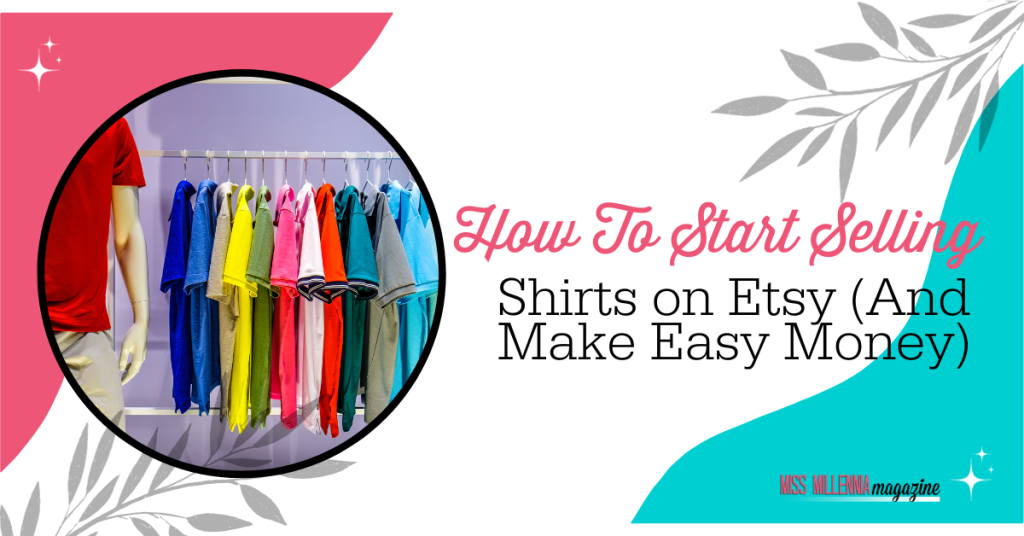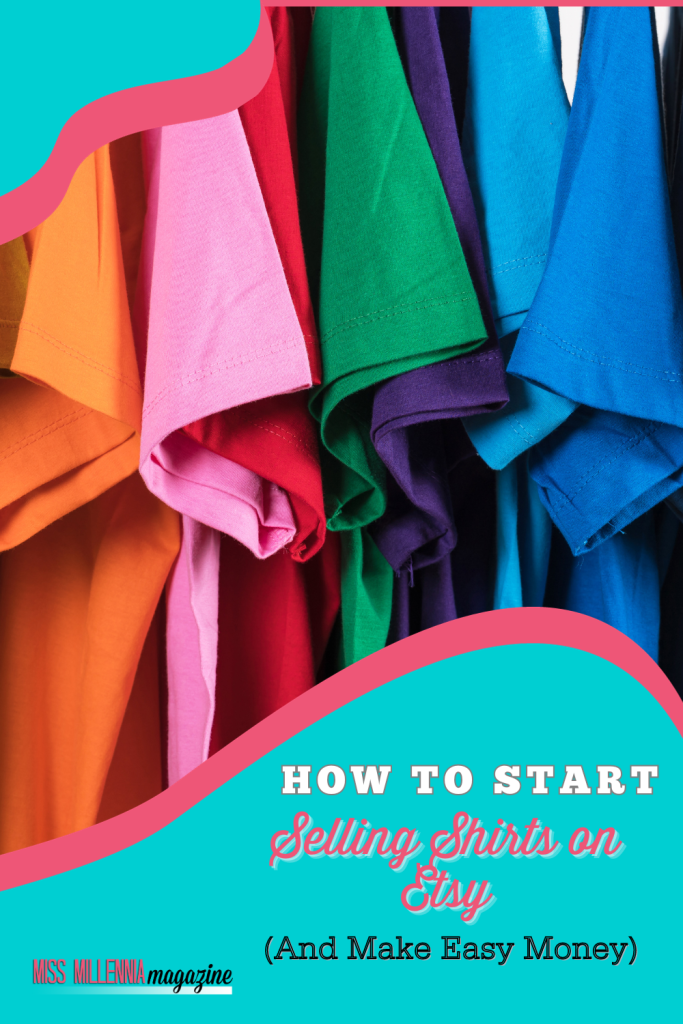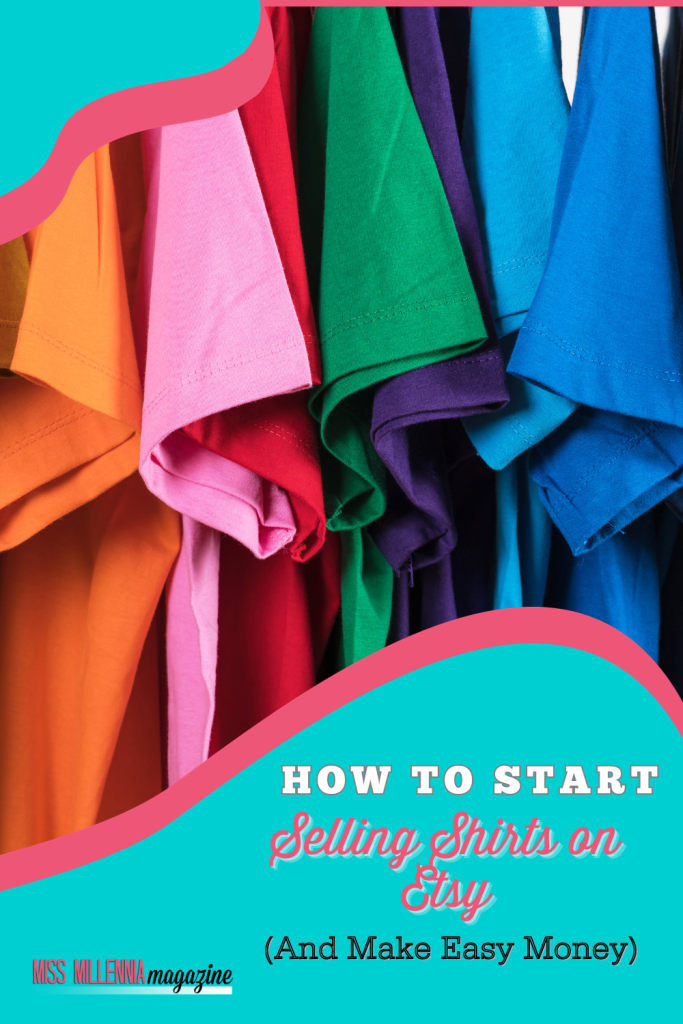How To Start Selling Shirts on Etsy (And Make Easy Money)

Etsy, an enormous online marketplace founded in 2005, is a beautiful place for anyone to showcase their creative and unique products. It is a great way to make some extra money. This perfect platform is geared to promote local small businesses like notable shirt-selling enterprises to gain more visibility and a fair price for the vintage items they sell, whether at the highest or lowest price.
If you are considering starting to sell shirts on Etsy, you have come to the right place. In this article, we will navigate the complexities of the platform together, understanding everything from basics to how you can set up shop and make easy money on this right platform. So let’s get started!
Understanding Etsy as a Marketplace
Before you can start selling your products on Etsy, it is crucial to understand the platform entirely. The Etsy marketplace can be overwhelming if you lack knowledge about it. The intricate Etsy ecosystem is designed to help you gain more visibility and attract more potential customers with a higher chance of conversions if the market research is done right.
Buy Directly From Someone Who Put Their Heart And Soul Into Making Something Special. Shop, Create, And Be Inspired By Unique Items You Can't Find Anywhere Else. Talented Creators. One-of-a-Kind Community. Unique & Vintage Items. Everyday Supplies.
Fundamentally, Etsy is about supporting a collective of autonomous merchants, artists, and artisans who display their ingenuity via various goods. Etsy sellers must improve the products they offer to be successful. This entails creating captivating narratives and utilizing high-quality photos, pertinent labels, and keywords. When they do this, vendors raise the possibility that their goods may appear in appropriate searches, drawing in more prospective customers and earning much money.
Interacting with the Etsy forum is also crucial. It is one of the best practices. A vendor’s exposure may be increased by participation in discussion boards, offering information, and displaying the production process. Creating a solid reputation and providing top-notch customer support are additional strategies for increasing visitors, improving a seller’s image, and drawing in recurring business, which mainly depends on favorable reviews and satisfied consumers.
Expanding the seller’s exposure may be accomplished using Etsy’s marketing resources like ads and promos. Goods may stand out among the site’s wide range of unique items by strategically utilizing sponsored marketing and offers.
In addition to these approaches, vendors must keep up with Etsy developments, regulations, payment methods, and algorithmic modifications. A seller’s exposure and revenues can be significantly impacted by adopting the latest functionalities and keeping up with the rapid shifts on the platform.
Etsy’s focus on telling stories and personalizing is additionally a contributing factor to the platform’s popularity. This is the best way. Vendors of different handmade items or other things may take advantage of this by narrating the story around their goods, how they come up with ideas, and the sources of motivation that guide their work. Sincere narratives strike a chord with consumers, creating bonds and increasing the attractiveness of the goods.
To establish a thriving business on Etsy, companies must proactively engage with the platform and the community of active sellers, provide good customer service, and adopt its altering functionalities.
Research and Planning Phase

In any entrepreneurial venture, especially when launching or growing an Etsy shop, researching and planning is crucial to building a solid foundation for profitability. This stage includes establishing targets, extensive study, and tactical decisions.
Observing the niche market: The first thing to do in research is to grasp the Etsy marketplace thoroughly. It entails examining the kinds of goods that sell successfully, determining the target consumers, researching the techniques used by various businesses, and spotting emerging trends in the industry. This stage involves analyzing competitive pricing tactics, common keywords or hashtags in related product groups, search results, and customer tastes.
Finding Your USP: The next step is to make your goods pop out from the thousands of others on Ets; you must figure out what makes your product distinctive (what is your USP). It entails determining what separates and attracts potential buyers to your apparel line. What sets your products apart from the competition might be their quality, style, fabrication, or graphics.
Clearly defining goals: Setting attainable goals for your business is essential. A business’s blueprint may be outlined with practical, immediate, and long-term objectives. This might involve deciding how many goods to offer, establishing sales goals, seeking out favorable client feedback, or growing the product selection over a predetermined time frame.
Formulating a Business Strategy: Creating an extensive business strategy is crucial. It includes several components, including the target audience, item range, price plan-like shipping price, advertising approach, inventory control, projected financials, and logistical planning. The strategy guides the company, offering guidance and instructions for carrying out its operations.
Financial Strategy: Creating a spending plan and calculating the first outlay of funds are essential. It includes figuring out how much it will cost for supplies, labor, cost of listing, transport, promotion, and additional running costs. Calculating earnings, transaction fees, listing fees, predicting sales, and ensuring the company can continue financially are all part of fiscal management for online store owners.
Selecting Appropriate Tools: The first step to effectively managing the Etsy business production partners is choosing the right assets and tools. Examples include using a dependable inventory control framework, monitoring profitability using analytics programs, order fulfillment, client interaction, and social networking control applications.
Approaching the Market: Designing a market entry plan must align with the business’s objective and vision. These comprise choices on the cost of the products, print-on-demand services, how many postings to start with, which promotional methods to employ, and how to interact with possible buyers.
Setting Up Your Etsy Shop
Setting up a shop on the Etsy platform through the Etsy app is a thrilling process and the first step in bringing you unhindered success in your marketing efforts. It is the primary step in developing an online identity and presence as a business offering distinctive products to an international audience pool. The following are the steps you must undertake to establish your Etsy shop successfully:
Open an Etsy Account: If not already, create an Etsy profile. Give essential facts like the Etsy shop name, address, and accepted payment methods.
Establish a Brand Persona: Establish your business’s identity by creating an eye-catching store name that accurately describes your offerings and designing an attractive logo. Maintaining a uniform brand identity throughout your store improves consumer awareness and builds trust.
Product Catalogs: Add top-notch images to your product postings highlighting your merchandise from different perspectives. Provide attention-grabbing, intriguing names and thorough descriptions highlighting every product’s unique qualities and advantages.
For improved exposure in searches, include suitable keywords.
Establish Delivery and Cost Plans: Ensure that your item’s average prices are explicit, considering the cost of materials, Etsy payments, manufacturing time, and targeted profit rates at different price points. All this must be a part of your business plan.
Specify shipping costs and guidelines (mention also if free shipping is available) along with the shipment locations and lead times.
Inventory Control: Maintain accurate stocks to avoid selling out and guarantee the availability of supplies, like craft supplies. Entries should be immediately updated when things are replenished or traded out.
Paying Options: Establish safe payment procedures for clients and pick your preferred payment choices—etsy accepts several means of payment, including PayPal, debit and credit cards, and Etsy vouchers.
Boost SEO: Make your items more visible by boosting them for internet searches to make them best-selling items. To increase the likelihood of your posts appearing in searches, include relevant search terms, identifiers, and classifications in your advertisements.
Advertise Your Store: Use blog posts, e-newsletters, social networking sites, and other promotional resources to increase visitors to your successful Etsy shop. Create an ecosystem surrounding your business by interacting with your target market.
Customer Support: Deliver outstanding client service by answering questions immediately, handling orders quickly, and ensuring loyal customers have a positive shopping experience. Good feedback and contented clients may attract new clients and encourage recurring business.
Designing and Creating Shirts
When trying to establish a shirt business on Etsy, the obvious essential step is designing and creating shirts. However, they should not be any run-of-the-mill unique designs. A sense of uniqueness is necessary to succeed in selling products on Etsy. Here is how you can let your creativity flow to monetize your Etsy sales successfully:
Innovate Creative Designs: First, develop concepts for the shirt’s patterns. Consider your intended audience, the newest fashions, and your distinctive aesthetic. Use programs for graphic design to make visual prototypes or draw out your ideas.
Select High-Quality Materials: Choose premium fabrics for your shirts. Think of the fabric’s lightness and feel in addition to its type—cotton, polyester, or a combination. Choose materials that go well with your patterns, are cozy, and are long-lasting.
Design Production: Use design programs, such as Illustrator by Adobe and Canva, to make your creations come to life. Try different fonts, hues, pictures, and images to see what works best for your business and what appeals to your target audience.
Printing Technique: Choose a technique that will work best for your designs. Typical choices include thermal transfer, direct-to-garment (DTG) printouts, and printing by screes. Every approach has advantages and disadvantages concerning price, effectiveness, and suitability for various new designs, like t-shirt designs.
Imagery: Take excellent pictures of your clothes that are visually attractive. Ensure the layout elements are well-lit and captured in crisp, high-quality images. To assist Etsy shoppers visualize donning the shirts, place them over lifelike models or figures.
Add Products to Etsy: Post the shirts’ advertisements on Etsy. Put your creations’ distinctive qualities front and center in captivating, keyword-rich names and summaries. Enhance visibility by using appropriate categories and hashtags.
Pricing Approach: Establish an income-generating yet reasonable cost for the shirts. Ensure your rates align with industry standards and consider labor, supply costs, manufacturing expenses, and targeted profit margins.
Packing and Delivery: Decide on packing choices and shipment strategies for your vintage clothing. To improve the unpacking experience for customers, provide dependable delivery facilities, and ensure that all packaging is safe and appealing.
Advertising: Use a variety of channels for advertising your shirts, such as email blasts, articles, and social networking sites. Interact with your target market to raise awareness and draw in ideal customers. Also, try to work with influential people and participate in topical gatherings.
Marketing and Promoting Your Shirts

Effective marketing means more significant traffic and conversions into sales. It is, therefore, essential to have a sound marketing strategy for selling products on Etsy.
Here’s how to go about it:
Improve Your Online Store: Ensure that the appearance and structure of your Etsy store are inviting. Provide attractive product descriptions with suitable search terms and excellent images of the garment advertisements. A polished, well-organized store layout increases client confidence and involvement.
Benefit from Social Media: To attract more people, advertise your apparel on social media sites. To attract customers to your Etsy shop, post striking images of your merchandise, interact with fans, and implement focused advertising strategies.
Engage Influencers in Collaboration: To promote your shirts, collaborate with influencers or celebrities. Partnering with influencers may increase your visibility and reputation, mainly if the celebrity’s demographic is similar to your intended demographic.
Offer Sales or Special Offers: Use promotions, price reductions, or package offers to attract Etsy customers. For an incentive to buy, consider holding sporadic specials or providing free delivery.
Email Advertising Campaign: Compile a directory of potential clients’ emails and occasionally distribute mailings highlighting your most recent designs, special offers, or the shadows shots. To get clicks on correspondence, use compelling headlines and eye-catching formatting.
Engage in Activities on Etsy
Harness market-specific advertising features seasonal themes and deals that Etsy supports. By joining such events, you may raise the awareness of your store and draw in Etsy’s target customer base during rush hour.
Seek Client Feedback: Invite pleased consumers to post feedback on your Etsy store. Good evaluations can sway prospective customers’ decisions by acting as social evidence.
Make Interesting Content: Provide more comprehensive audience-relevant material compatible with your t-shirt creations. Blog entries, audiovisual instructions, or the backstories of your products might all go under this category. Engaging content may convey the character of your brand, such as a t-shirt brand, while drawing in and keeping customers.f
Observe and Adjust: Utilize Etsy’s metrics and additional resources to evaluate your marketing campaign’s success continually. With the information acquired, modify your tactics and concentrate on the most effective for your store and target market.
Conclusion
Observing and playing around with these marketing strategies will make you attract customers to your business in the short term and become comfortable with Etsy’s functions and features. This kind of understanding of the platform will help you make quick adjustments and stay on top despite periodic algorithmic changes.
Establishing a shirt business on Etsy is an exciting endeavor. It is also an excellent way to start your business, expand it to go beyond local borders, and increase your visibility on a global scale. By conducting prior research, anyone can become a master at selling products on Etsy, gaining a new avenue to market and advertise products that would otherwise only be available to a small audience. So, sell on Etsy and make money with these guidelines.










